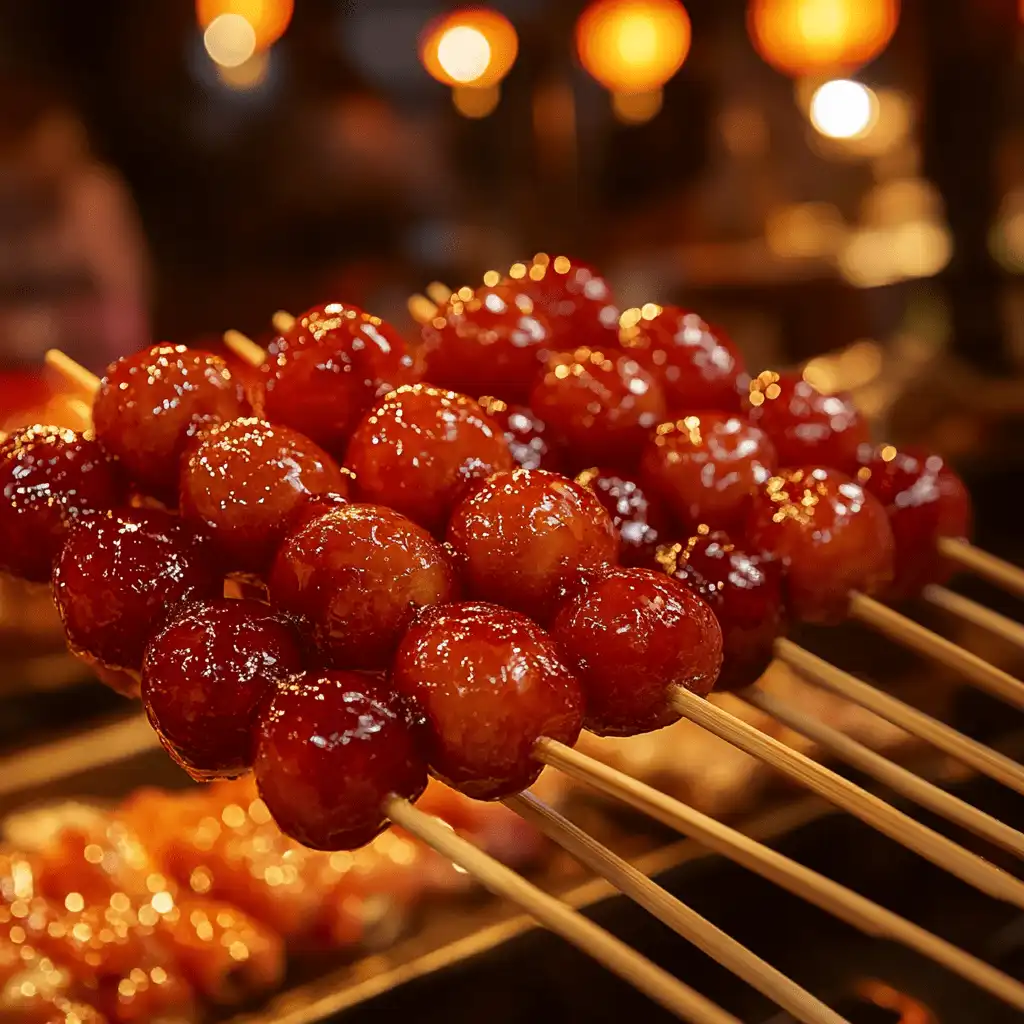Have you ever wondered what’s up with those glossy, fruit-covered skewers in Chinese street markets? That’s Tanghulu, a beloved traditional snack known for its irresistible combination of sweetness and crunch. Originally a simple sweet treat enjoyed by children, these candied fruit sticks have taken the world by storm.
Let’s dive into the sticky, sugary story of Tanghulu and maybe even convince you to try making it at home (spoiler: it’s easier than you think, unless your sugar syrup decides to stage a rebellion).
Table of Contents
The Origins and History of Tanghulu
Tanghulu’s origin story sounds like something out of a foodie fairy tale. Back in the Song Dynasty (over 800 years ago!), a physician supposedly crafted this treat to cure a concubine’s mystery illness. His remedy? Tart hawthorn berries coated in hardened sugar, believed to aid digestion. Whether it worked or not, the combo of sweet and sour was clearly a hit soon, everyone from peasants to emperors was munching on these jewel-like skewers.
Beyond its delicious taste, Tanghulu carries cultural meaning in Chinese tradition. The bright red color of hawthorn berries symbolizes prosperity and good luck, making it a favorite treat during festivals like the Lunar New Year. Street vendors sell it during winter, as the crisp, cold air helps maintain its signature hard candy shell.
Even today, Tanghulu is deeply rooted in nostalgia. Many people associate it with childhood memories of walking through bustling night markets or enjoying a sweet treat on a cold winter evening.
Ingredients and Variations
Print
Tanghulu
- Total Time: 20 min
- Yield: 6 skewers 1x
Description
Tanghulu is a traditional Chinese street snack made by coating fruit in a crisp, glossy sugar shell. Originally made with hawthorn berries, this treat now features a variety of fruits like strawberries, grapes, and oranges. The satisfying crunch and sweet-tart balance make it an irresistible dessert. Follow this easy recipe to make authentic Tanghulu at home!
Ingredients
- 18 fresh hawthorn berries, strawberries, grapes, or other firm fruit
- 1 cup granulated sugar
- ½ cup water
- ¼ teaspoon lemon juice (optional, helps prevent crystallization)
- 6 wooden skewers
- Parchment paper (for cooling)
Instructions
Step 1: Prepare the Fruit
- Wash the fruit thoroughly and pat completely dry with a paper towel. (Any moisture will prevent the sugar from sticking.)
- Thread 3 pieces of fruit onto each skewer, leaving some space between them.
Step 2: Make the Sugar Syrup
- In a heavy-bottomed saucepan, combine sugar, water, and lemon juice over medium heat.
- Do not stir—let the sugar dissolve naturally.
- Allow the mixture to reach 300°F (150°C) (hard crack stage) on a candy thermometer. The syrup should be clear and slightly golden.
Step 3: Coat the Skewers
- Carefully dip each skewer into the hot syrup, twirling to coat the fruit evenly.
- Let excess syrup drip off, then place the skewer onto parchment paper to cool.
- Repeat for all skewers, working quickly before the syrup hardens.
Step 4: Let It Set
- Allow the Tanghulu to cool at room temperature for 5–10 minutes until the candy shell hardens completely.
- Serve immediately for the perfect crunch!
Notes
- Prevent Sugar Crystallization: Adding a little lemon juice or a tablespoon of corn syrup helps keep the sugar syrup smooth.
- Work Fast: The syrup cools quickly, so dip the skewers immediately once it reaches the right temperature.
- Best Fruits for Tanghulu: Besides hawthorn, try strawberries, grapes, kiwis, blueberries, or even pineapple chunks.
- Storage: Tanghulu is best eaten fresh. If needed, store in an airtight container at room temperature for up to 4 hours.
- Prep Time: 10 min
- Cook Time: 10 min
Nutrition
- Serving Size: 1 skewer
- Calories: 140 kcal
- Sugar: 32 g
- Sodium: 0
- Fat: 0
- Saturated Fat: 0
- Unsaturated Fat: 0
- Trans Fat: 0
- Carbohydrates: 36 g
- Fiber: 2 g
- Protein: 1 g
- Cholesterol: 0
Traditional Ingredients
At its core, Tanghulu is a simple treat with only two essential ingredients:
- Fruit: Traditionally, this would be Chinese hawthorn berries (shanzha). If you’ve never had them, picture a mix between an apple and a cranberry and then some. They’re tartness cuts perfectly through the sweetness of the hardened sugar coating.
- Sugar Syrup: A mixture of white sugar and water, heated until it reaches the perfect caramelization stage to ultimately form the crispy outer shell.
Popular Fruit Variations
Modern versions of Tanghulu showcase a variety of fruits, each offering a unique flavor and texture:
- Strawberries are naturally sweet and pair perfectly with the crunchy sugar shell.
- Grapes are juicy and refreshing, adding a burst of flavor with every bite.
- Mandarin Oranges their citrus taste enhances the balance of sweet and tangy.
- Kiwi Slices make for a tart, tropical variation that adds visual appeal.
- Bananas though softer in texture, they are still delicious when combined with the hardened sugar coating.
Sometimes you can even find mixed-fruit skewers, combining different flavors in one serving!
Alternative Coatings and Twists
Beyond the classic hardened sugar, new twists have emerged:
- Honey-Coated for a natural alternative with a slightly softer crunch.
- Chocolate-Dipped adding a layer of chocolate over the sugar shell for extra indulgence.
- Sesame or Crushed Nuts are sprinkled on top of the sugar shell before it hardens for added texture and flavor.
I once tried a “spicy” version in Chengdu, dusted with chili flakes. Verdict: confusing, chaotic, and weirdly addictive.
DIY Tanghulu: A Sugar-Coated Adventure
Essential Tools and Equipment
Making Tanghulu at home is part cooking, part science experiment. Here’s how to avoid turning your kitchen into a caramel crime scene:
You’ll Need:
Skewers (or chopsticks in a pinch , we don’t judge)
A heavy pot (non-stick is your friend)
A candy thermometer (or good instincts)
Step-by-Step Recipe
- Prepare the Fruit – Wash and thoroughly dry your fruit like it’s a rainy day: Any moisture = sugar sliding off like a bad breakup. Pat those berries like you mean it.
- Skewer the Fruit – Arrange 3-4 pieces of fruit per skewer. Make sure they are evenly spaced.
- Sugar Syrup 101: Mix 1 cup sugar with ½ cup water. Heat until it hits 300°F (150°C) the “hard crack” stage. Pro tip: Don’t stir. Just…trust the process.
- Dip & Twirl: Swirl your skewers in the syrup like you’re conducting a sugary orchestra. Too slow? You’ll get a glob. Too fast? A sad, patchy coat. Channel your inner Goldilocks.
- Cool It: Let them harden on parchment paper. Resist the urge to poke—this isn’t the time for commitment issues.

Pro Tips
- Work fast Sugar syrup hardens quickly, so dip your skewers immediately.
- Test the sugar stage Drop a little syrup into cold water; it should harden instantly and snap when broken.
- Save this for dry days. My first attempt looked like fruit wrapped in cellophane. Turns out, humidity is the enemy.
- If your syrup crystallizes, you’ve got science fair material not Tanghulu. Start over, and maybe whisper sweet nothings to the pot.
Health Benefits and Nutritional Value of Tanghulu
Is Tanghulu a Healthy Snack?
Let’s Get Real, it’s fruit wearing a sugar coat not a kale smoothie. But compared to a candy bar? Tanghulu’s a Renaissance man:
Hawthorn: Packed with antioxidants and fiber (it was medicine once, remember?).
Strawberries/Grapes: Vitamin C party!
Nutritional Breakdown
A 3-piece skewer runs you ~150 calories. Could you swap in honey or monk fruit sugar? Sure. But sometimes? Life’s too short not to let sugar sparkle.
The exact nutritional value depends on the fruit used. Here’s a general estimate for a three-piece hawthorn skewer:
- Calories: ~120-150 kcal
- Carbohydrates: 30-40g (mainly from sugar)
- Fiber: 3-5g (higher in berries and citrus fruits)
- Vitamin C: 10-20% of daily intake (varies by fruit type)
Ways to Make Tanghulu Healthier
If you want a more nutritious option, try these tweaks:
- Use less sugar : A thinner candy coating reduces overall sugar content.
- Experiment with sugar substitutes : Some people use monk fruit sweetener or coconut sugar for a different taste.
- Pair with nuts or yogurt : Adding a protein source balances out the sugar rush.
At the end of the day, Tanghulu is a fun and tasty treat and like most things thar are this much fun, probably best enjoyed in moderation.
5 Things You Didn’t Know About Tanghulu
It’s a Time Traveler: Those hawthorn skewers your grandma loved? Identical to ones from the 1200s.
Maltose Magic: Old-school versions used malt syrup for a deeper, almost buttery sweetness.
Gourd Goals: The name “Tanghulu” literally means “sugar gourd” a nod to its shape.
Bean Surprise: Some versions stuff hawthorn with sweet red bean paste. Sweetception!
TikTok Fame: #Tanghulu has over 500M views. Move over, dalgona coffee.
Looking for More Sweet Treats?
If you love exploring unique desserts, check out this delicious recipe for Banana Bread Cookies.
Frequently Asked Questions
“Can I use watermelon?”
Only if you enjoy sticky floors. High-water fruits = sugar slide-off.
“Why’s my coating still sticky?”
Didn’t hit 300°F. Or it’s humid. Or the universe hates you. Try again on a dry day.
“How long does it keep?”
Ideally? Eat it NOW. But if you must, store it airtight (not in the fridge though, because condensation = sadness).
Some people even freeze tanghulu but this might seriously affect the texture.
“Candy apple’s cousin?”
More like its cool aunt who travels the world. Thinner shell, smaller fruit, zero cinnamon drama.
Should You Try Making Tanghulu at Home?
Final Verdict: Make This Now!
Tanghulu isn’t just a snack, it’s a story on a stick. For everyone chasing nostalgia, Instagram cred, or just a sugar rush, this treat delivers. Sure, your first batch might look like a preschool art project, but that’s part of the fun. Invite some friends over and make an afternoon out of it. Tanghulu is a snack that’s as fun to eat as it is to make.
And while you’re at it you can also give these Gluten Free Goldfish Snacks a try!

